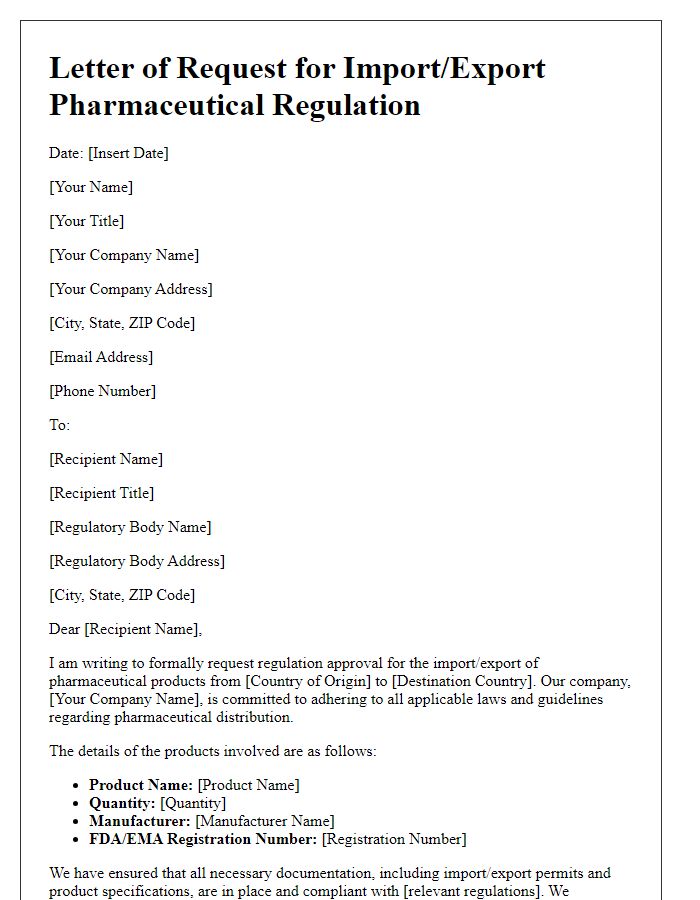Are you navigating the complex world of pharmaceutical regulations? Whether you're a seasoned professional or a newcomer to the field, understanding the nuances of compliance can be a daunting task. In this article, we'll explore key strategies and best practices to ensure your pharmaceutical operations align with regulatory requirements. So, grab a cup of coffee and let's dive deeper into this essential topic together!

Regulatory compliance guidelines
Regulatory compliance in the pharmaceutical industry encompasses ensuring adherence to established guidelines set forth by entities such as the Food and Drug Administration (FDA) in the United States and the European Medicines Agency (EMA) in Europe. These regulations, including the Good Manufacturing Practice (GMP) standards, dictate the necessary protocols for drug production to ensure safety, efficacy, and quality. Key aspects involve rigorous documentation processes, clinical trial requirements, and post-marketing surveillance to monitor drug performance in real-world scenarios. Additionally, pharmaceutical companies must navigate complex labeling regulations that dictate what information must be disclosed about potential side effects and usage instructions. Compliance to these guidelines is critical for avoiding sanctions, ensuring market access, and maintaining public trust.
Documentation requirements
Pharmaceutical regulation compliance mandates comprehensive documentation requirements across various stages of drug development. Key documents include Investigational New Drug applications (IND) filed with the Food and Drug Administration (FDA), which necessitate detailed information regarding clinical trial protocols and preclinical data. Manufacturing processes must adhere to Good Manufacturing Practices (GMP), ensuring documentation of batch production records and quality control measures. Additionally, post-marketing surveillance requires submission of periodic safety update reports (PSUR) to monitor adverse event data. Regulatory compliance varies by region; for instance, the European Medicines Agency (EMA) has specific guidelines for marketing authorization applications (MAA) that include substantive clinical data and summaries of efficacy. Proper filing and maintenance of these essential documents can significantly impact the speed of approvals and overall success in bringing pharmaceutical products to market.
Relevant legal frameworks
Pharmaceutical regulation is governed by comprehensive legal frameworks that ensure drug safety, efficacy, and quality. In the United States, the Food and Drug Administration (FDA) oversees pharmaceutical regulations under the Federal Food, Drug, and Cosmetic Act (FFDCA), which includes guidelines for clinical trials, drug approval processes, and post-market surveillance. In the European Union, the European Medicines Agency (EMA) regulates pharmaceuticals, guided by directives and regulations that harmonize standards across member states, including Regulation (EC) No. 726/2004. Additionally, the International Conference on Harmonisation (ICH) provides global guidelines aimed at streamlining drug development and approval procedures. Countries such as Japan and Canada also have their respective regulatory bodies, the Pharmaceuticals and Medical Devices Agency (PMDA) and Health Canada, implementing frameworks similar to those in the US and EU. Understanding these legal frameworks is crucial for regulatory compliance and successful pharmaceutical market entry.
Submission timelines
Pharmaceutical companies must adhere to strict submission timelines for regulatory approvals to ensure the timely introduction of new therapeutic drugs. The U.S. Food and Drug Administration (FDA) typically requires a New Drug Application (NDA) to be filed within 60 days after the completion of Phase 3 clinical trials, which involve thousands of patients and can take several years. Once submitted, an NDA undergoes a standard review period of 10 months, although some medications can qualify for priority review, reducing that timeline to six months. Furthermore, with the recent advancements in the 21st Century Cures Act, a streamlined process known as Fast Track may allow for earlier interactions with regulatory bodies, promoting quicker access to medications that treat serious conditions. Companies must plan carefully, ensuring all required clinical data, manufacturing information, and labeling details are precisely prepared to meet these deadlines.
Post-market surveillance protocols
Post-market surveillance protocols play a crucial role in ensuring the safety and efficacy of pharmaceutical products following their approval by regulatory bodies such as the FDA (Food and Drug Administration) or EMA (European Medicines Agency). These protocols involve systematic data collection and analysis regarding drug performance, adverse events, and patient outcomes in real-world settings. Reporting mechanisms, such as the MedWatch system in the U.S., enable healthcare professionals and consumers to report any unexpected reactions or side effects, ensuring timely identification of potential safety issues. Furthermore, periodic safety update reports (PSURs) must be submitted to regulatory authorities, providing comprehensive assessments of benefit-risk profiles based on real-world data. Adherence to these guidelines is essential for maintaining public trust and compliance with international standards, such as GxP (Good Practice) regulations.













Comments